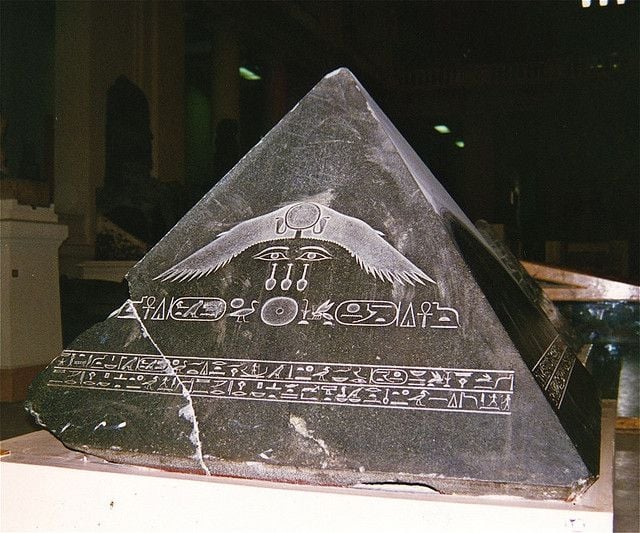The Amenemhat III pyramidion was the capstone that initially adorned the Black Pyramid in Dahshur, Egypt. It was built approximately 1850 BC, near the conclusion of the 12th Dynasty during the Middle Kingdom, and it is one of just a few pyramids that have survived. But what was an Ancient Egyptian Pyramid’s capstone made of?
These white Tura limestone stones would have provided the pyramid with a flat surface that was dazzling and reflecting. A capstone, known as a pyramidion, would have sat at the top, maybe covered in gold.
Egypt’s Pyramidions
True Egyptian pyramids, as opposed to step pyramids, were topped by a specific stone known as a pyramidion, or occasionally a capstone, a miniature pyramid. The pyramid structure was brought to a point with the same angle and proportions as the main body. The ancient Egyptian word for the pyramidion, which may also sit atop the pinnacle of an obelisk, was ben-benet, named after the sacred ben-ben stone preserved in Heliopolis Temple, Egypt’s earliest center of sun worship.
They were mainly formed of diorite, granite, or a magnificent limestone during the Old Kingdom and then coated in gold or electrum. They were usually built of granite and etched with writings and symbols by the Middle Kingdom and the end of the Pyramid Age. (Source: Tour Egypt)
The Pinnacle of Pharaonic Power
The Egyptian Pyramids are more than just enormous tombstones for pharaohs who have passed away. When a pharaoh died, the Ancient Egyptians thought he became Osiris, the King of the dead. They believed that for the dead pharaoh to fulfill his duties as King of the dead, his ka, soul or spirit, that remained with the body needed to be cared for. The pyramid served as a place of rest for the deceased pharaoh. (Source: History on the Net)
The Pyramid’s Construction
The Egyptian pyramids were constructed by competent laborers who were compensated. During the flood season, farmers were frequently enlisted to assist with pyramid construction.
There are numerous ideas as to how the Ancient Egyptians built the pyramids. Large chunks of stone have been brought along the Nile to the Giza site. They were then brought into position with the use of sleds and ramps. (Source: History on the Net)
The Great Pyramid from Within
The Great Pyramid’s entrance leads to a descending passage about 1 meter wide and 1.2 meters high. The corridor leads to the underground room at a 26-degree angle. The underground chamber is thought to have been a counterfeit burial chamber to deceive tomb robbers, or the King changed his mind about his last resting place.
The Grand Gallery has reached via an ascending route the same size as the descending passage. Another horizontal path acquires the Queen’s chamber. The Queen’s chamber was never completed. Therefore the floor remains uneven, and the walls need to be unadorned. This was supposed to be the King’s room, but the tunnel was too low and small for the King’s tomb. Thus it was abandoned.
The Grand Gallery, which leads directly to the King’s chamber, measures 48 meters in length and 8.5 meters in height. The King’s Chamber measures 5.2 meters by 10.8 meters and is 5.8 meters tall. The chamber’s inside is made of polished pink granite. Inside the room lies a stone sarcophagus, where the King’s mummified body would have been put. (Source: History on the Net)
